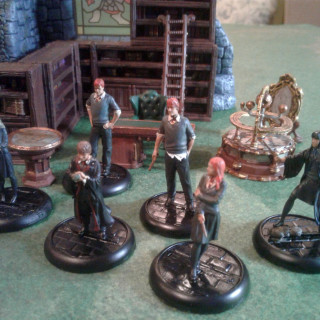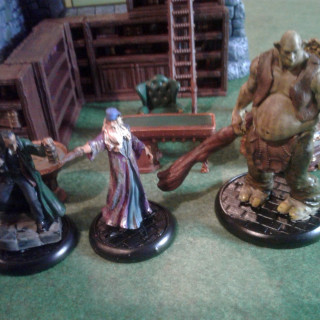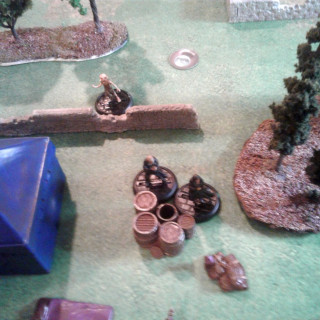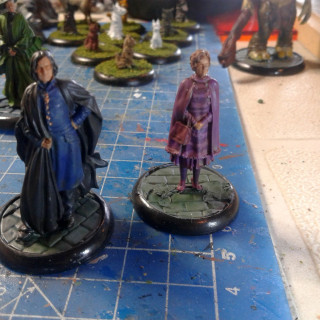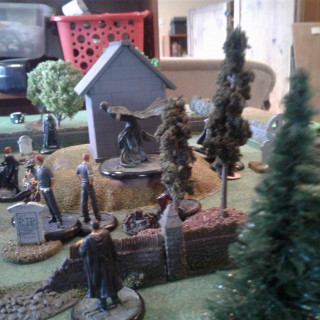
Harry Potter – Board to Tabletop
Recommendations: 28
About the Project
The Harry Potter Miniatures Adventure Game is played on square-gridded, double-sided boards. They can be arranged in different ways for the published scenarios, and while their artwork evokes themes from the Harry Potter universe, they are rather generic and bland in relation to the minis. Keeping most of the boardgame rules for the mechanics of how things worked, I tweaked things a little to take the game off of the board and onto a proper tabletop. This project shows the first kick at the can with the hope of refining it through more playthroughs. **mini painting (and basing) are WIP**
Related Game: Harry Potter Miniatures Adventure Game - Wizarding Duels
Related Company: Knight Models
Related Genre: Fantasy
This Project is Completed
Introduction - trapped on a board
I jumped into the Harry Potter Minatures Adventure Game (Knight Models) during the pre-order last March, as my daughter is a big fan, but not too interested in tabletop gaming (though Burrows & Badgers ticks a box). Through a freight forwarder, I was able to get my shipment to Canada (game was only initially licensed for release in Spain, UK, USA). There was a bit of delay for the two hop shipping, but I still received my Hogwarts Pack bundle before many, if the posts on the Knight Models Facebook page are to be believed.
The Hogwarts Packs was not the all-in bundle and contained the core game, Dumbledore’s Army, Slytherin students, Weasley twins, Troll Adventure pack as well as as some pre-order exclusives – Dobby, Kreacher, Filch & Dumbledore. A good assortment of characters, focusing more on the students of Hogwarts instead of the wider wizarding world.
As seemed to be a common problem, the packing was not great. The core box was missing legs for Harry, Ron and two Death Eaters while having an extra upper torso for both Harry and Ron as well as an extra acromantula. The minis are resin and a few had broken components, which were fairly easy greenstuff fixes. Replacement parts from KM were rumoured to be a months-long prospect, so with some timely guidance from Michael Lovejoy in the Projects system (Burrows & Badgers sculpting – that man is a craftsman!) I set to making Harry and Ron whole again. Several attempts allowed me to get servicable legs built on a wire framework that ended up sort of to scale. My sculpting ability is slightly above worm and snowman level, but not too far.
Then it came time to try the game … It’s … not bad. The spell mechanics are interesting with a countdown timer and thematic effects. Other aspects are a little clumsy with the use of the various quest and adventure cards. My biggest concern was the boards. While they are filled with familiar Harry Potter imagery, they are too generic and don’t evoke a sense that you are in any specific location referenced by the scenarios. After a few lacklustre games, I was thinking of how to break the game free of the board.
Board Game to Tabletop
I didn’t want to vary too much from the game to make use of the same components and have their text and rules still make sense. In moving to the tabletop, I simply converted spaces and ranges to inches (1 space = 2″, though I capped a move action to 4″ to keep the play area manageable). Line of sight and cover rules became familiar ‘model’s eye’ calls with 3D terrain. This simple conversion and some common sense worked well – not a tournament ready ruleset, mind you – but definitely playable in a more visually appealling environment.
My current terrain collection runs more to pulp/modern and sci-fi or generic rural, walled fields/woods. I did just get the Battlefields Terrain Crate from Mantic and the combination of that with what I had led quickly to a Quidditch World Cup set-up. A simple scenario with VP for knocking out opposing models and random objectives was made and the teams drawn up to a 60 galleon limit.
Game in action
The Hogwarts side (played by my daughter) consisted of Harry, Ron, Hermione, Luna and Dobby. The Death Eater side had Draco, Crabbe, Goyle, Pansy Parkinson, two Death Eaters and an acromantula. Harry and Hermione cost a few points more than the Slytherin students, but have an extra spell slot and better casting ability and defense from traits or special rules. Dobby was interesting as an Elf-type. Has an innate magical strike attack, but can also take a single spell that does not need to roll for success. My daughter chose Apparition which proved to be a good pick on several occasions.
Both sides split into two groups and made good use of cover as they closed on objectives. Objectives are scored by getting enough models with a cumulative total in one of the traits within proximity to a marker. We placed 3 markers at the beginning of the game and the cards can generate further markers.
Dice tests for attack and defense were used straight from the board game – 3 dice, 3+ tests with auto successes added based on each character’s magical mastery or defense. Sixes (Deathly Hallows) explode for more rolls. Hermione was an early target and it took focused effort to knock her out (good defense plus innate Counterspell kept her going). Each model can take 4 levels of damage with detrimental effects for each level gained.
Harry, Dobby and Luna held their own until Dobby ultimately fell (Dobby!). Ron held out until nearly the end before succumbing along with all but a Death Eater and Draco from the other side.
All in all, the game converts easily to the tabletop without too much tweaking. The use of the different card decks in the game might stand to be trimmed – probably dropping the Quest deck altogether which generates objectives and random scoring events during play. The Event deck flips a card at the start of each round with interesting effects. The Adventure deck normally lays out a shared group of 3 cards each round either player can use. This becomes a little awkward on a larger tabletop so we switched it to a hand of three cards for each player (replenished each round). Each card has a choice of two effects on them. I found these worked well, though I might go through and cull a few cards that don’t fit.
Visually, playing on the tabletop really brings the game to life and fixed what I found to be the greatest drawback of the board version. Many ideas spring to mind for terrain to place these great looking minis in better surroundings.
Tabletop game shaping up
Have been tinkering with this for the past while, trying to transition this game a little better to the tabletop while still making use of the boardgame mechanics and components. I’ve found a lot of the extras in the game, the various card decks most notably, seem tacked on and don’t add much theme or much gameplay wise. We have gone through a few iterations where we stripped everything back to the basic dice and stat processes and built from there.
First off though, we received a few more minis to throw in the mix with the Hogwarts teachers as well as Hagrid and Fang and a Dementor. We’re still a bit light on Death Eater/Slytherin forces as, five months on, I’m still waiting for replacement parts from KM to build my last two Death Eaters from the core box. Might have to try my hand at sculpting again to get them on the board.
Latest Tested Changes
Tests and dice rolls – The basic mechanic is a 3 dice test, success on 3+, 6’s explode. To that, you would add auto-success for character skill – typically 0, 1, 2, or 3 from magic Mastery or Defense. However, it tends to balance out too often, with the defender winning ties, so there was a whole lot of nothing happening.
So what have we done?
- Skill levels add dice to the test instead of auto-success. More dice thrown, more 6’s rolled, greater variation
- Some traits and events can add bonus Mystery or Jinxed dice to a roll. The boardgame has an odd rule about how Jinxed dice are used, changing which dice are used to determine success, but is not compatible with a varied dice pool. Jinxed dice (i.e. added when your target is in cover), are rolled, but 3+’s rolled on them count as a -1 success, and they can explode too.
Activations and power points
The boardgame allowed a model to do a basic action (move) and an advanced action (cast spell, potion, etc). Initially we followed this line, though allowed the advanced action to be replaced by a second move, if desired. All base moves were converted from spaces to 4”, with bonus spaces from traits allowing an additional 2”.
The single advanced action limit is a bit of a drag for most characters (students) for a couple of reasons. First, they all generally have the trait Apprentice, which lets them cast the first spell each round for 1 less power point. A pool of power points based on a Cunning stat is generated at the start of the turn. Students generally add 2 (Harry, Draco, Hermoine) or 1 (most everyone else). But they are still limited to 1 advanced action which means they typically cast a spell for free, can’t do anything else and leave a pool of power points unspent.
On the drawing board (only had a couple of games testing this, but like where it is going).
- If a character successfully defends against an attack (rolls equal or higher # of successes), they can immediately take an action. This can be a move or an advanced action – cast spell, use potion, etc. This has worked well. Spells have a countdown timer, so a character couldn’t use the same spell repeatedly in a round, but could use other spells or other actions. This uses up the unspent Power Points as well as lessens a model being a target simply because they have activated already.
Cards and gameplay, victory conditions
The boardgame uses three separate card decks to inject some flavour and variability into the game – Adventure, Campaign and Quest cards. The campaign and quest cards are mostly involved with generating random objectives for victory points during the game. Each character card has 4 sub-stats (Magic, Temper, Courage, Wisdom) with a value between 0 and 10. An objective is ‘solved/won’ when you get enough characters close by that equal or exceed a total in one of the stats. Most characters, or at least my mix from the core plus a few expansions, tends to be either very low (0 or 1) or high (8+) in these stats. It became either very easy or nigh impossible to complete an objective.
Solution? – an easy one, we got rid of the Quest and Campaign decks as well as random objectives and just got creative with custom scenarios and victory conditions. We keep a static 1VP per model eliminated, but have a core goal and/or side conditions worth 1-3-5 VPs to mix it up. Still some work to do on scenarios as we really have just been trying to nail the mechanics
The Adventure deck we hung on to, though instead of a common pool per the boardgame, we let each player hold a hand of three, replenished at end of round. These cards list two effects and provide some minor buffs to rolls, movement, or conditions. These work well.
Next steps – Getting close to a fairly light and fast-paced game with these changes that plays differently from the boardgame and makes good use of the fluidity and freedom of getting off a grid. Damage and knocking models out of the game is my only real sticking point. Normal models can take 4 levels of damage before being removed with some activation penalties the worse off they are. Larger models (Troll, Hagrid) can take a lot more and even with our tweaks, it is rare for a model to be knocked out entirely. Will try damage points equal degree of success (attacker success – defender successes) and see how that goes.
Till next time …

































![How To Paint Moonstone’s Nanny | Goblin King Games [7 Days Early Access]](https://images.beastsofwar.com/2024/12/3CU-Gobin-King-Games-Moonstone-Shades-Nanny-coverimage-225-127.jpg)








